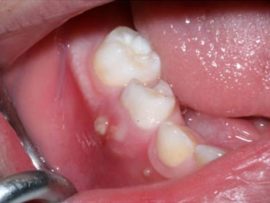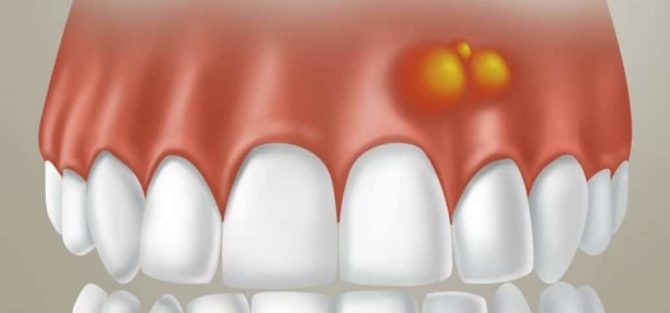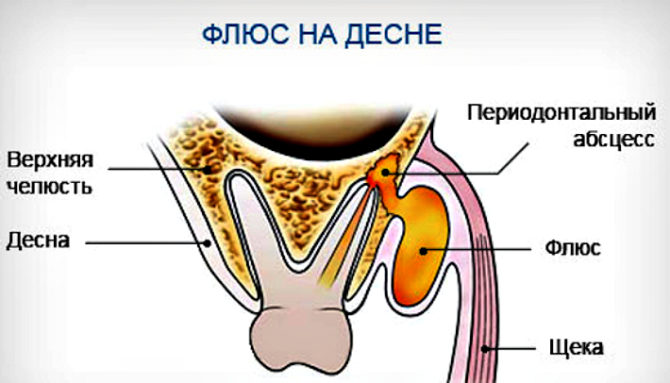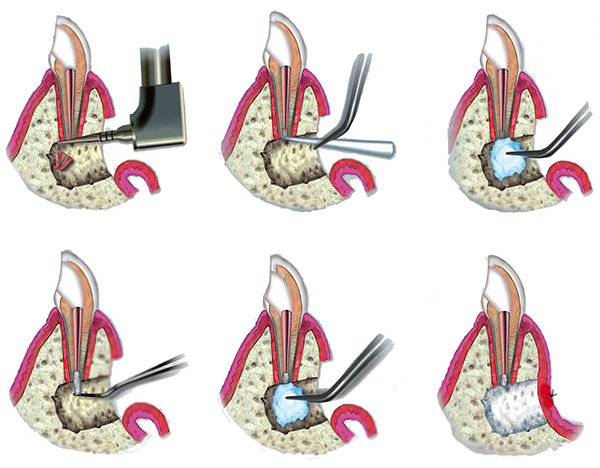Pus in the gums: what to do at home, surgical and medical treatment
Inflammation of tissues and accumulation of pus in any part of the body causes a person many problems - from constant pain and heat to the risk of spreading infection throughout the body. Particular discomfort appears when the gum becomes inflamed, since an abscess in the mouth interferes with normal eating and talking. The treatment of diseases accompanied by the release of pus from the gums near the tooth should be carried out under the supervision of a dentist, but it is possible to supplement therapy with traditional medicine methods.
Content
Suppuration and symptoms
If an infection gets into the gums, the body develops a protective response - inflammation. It is accompanied by a more intense flow of blood to the affected area so that immune cells can concentrate around the accumulation of pathogens. Because of this, the tissues swell, redden, and pain appears. With the accumulation of killed pathogenic microorganisms and dead immune cells, pus accumulates in the inflamed area.
An abscess in the gum becomes noticeable in the early stages of its formation. At this time, a person may notice that:
 Pain appeared, the gum hurts especially badly while chewing food and brushing your teeth.
Pain appeared, the gum hurts especially badly while chewing food and brushing your teeth.- Pus and blood are released from the abscess with pressure on the gum or while brushing your teeth.
- The gum swelled and turned red, the abscess can be visible on the surface in the form of a whitish tumor.
- The cheek is swollen.
- With an increase in purulent inflammation, the general body temperature may increase.
- Rapid inflammation can make a tooth mobile and cause it to fall out.
Despite all the uncomfortable sensations, an inflammatory reaction is necessary to neutralize dangerous microbes. But in many cases, the immune system is not able to completely suppress the infection without the risk of complications, so this pathological process should be treated.
For successful treatment, it is necessary to identify the cause of decay of the gums and make a diagnosis, which is possible only when visiting the dentist. Even if the abscess opened itself, and the pus comes out of the gums, it can accumulate again, so the doctor will still have to be treated.
Why is the gum festering?
It is impossible to determine on your own why a tooth has decayed or gum decays, because this pathological process is nonspecific and can occur with a variety of dental diseases. Among them, the most famous are:
| Disease | Localization of inflammation | Possible reasons |
|---|---|---|
| Periodontitis | Periodontal, at the apex of the tooth root. | Running caries, pulpitis, poor-quality filling of dental canals. |
| Gingivitis | Periodontium. | The accumulation of bacteria with poor oral hygiene, traumatic manipulations in dentistry. |
| Periodontitis | Periodontium. | Violation of the integrity of the dental cells due to insufficient nutrition of tissues, weak immunity and hereditary predisposition. |
| Periostitis | Periosteum of the jawbone. | Neglected caries, spread of infection through lymph and blood. |
| Osteomyelitis | Bone tissue of the jaw. | Injuries, caries, infection from other infected organs through blood or lymph. |
| Pericoronitis | Gum around the tooth (more often - near the wisdom tooth). | Incorrect teething, its deviation. |
Injury to the gums with a sharp object, an uncomfortable denture, when visiting dentistry or with inaccurate brushing of teeth is one of the main causes of infectionand non-compliance with oral hygiene increases the risk of infection in the wound.
The likelihood of developing gingivitis, periodontitis and other diseases is increased by metabolic disorders and hormonal disorders, as well as weak immunity and malnutrition.
Dental treatment
Treatment of purulent gum disease includes the following steps:
- A thorough examination, if necessary, will have to do an x-ray of the jaw.
- Cleaning gums and teeth of food debris and tartar.
- Dissection of the gums in the area of inflammation to remove pus.
When pus comes out of the gums, the patient is prescribed a course of drug therapy in order to avoid its repeated accumulation. It includes taking antibiotics and anti-inflammatory drugs, as well as rinsing.
If the pus comes with pressure on a sealed tooth, you will have to remove the fillings and clean the sealed channelsto remove purulent discharge. Carious cavities should be cleaned out, since they also accumulate infection in themselves. The dentist can establish temporary fillings, which, in case of recurrence of pus accumulation, can be removed to re-clean the canals. Permanent fillings and crowns are installed only when it is possible to pull the pus out of the tooth, and after an X-ray that shows the absence of inflammation.
Surgery
If the gum is festering due to improper filling of the canals, and the problem areas are located at the very top of the root, it can be surgically cut off - by resection. With this method, you can quickly get rid of a small abscess, which does not diverge to the entire space near the tooth. During the operation, an abscess is first opened so that pus comes out of it, and therapeutic measures are taken to relieve the inflammatory process, and then the removal itself is performed.
In advanced cases, when due to pus, the tooth can no longer be cured and poses a threat to health, it must be removed. After the operation, a drainage is inserted into the inflamed tissue for the outflow of pus, and a course of antibiotics is prescribed.
Additional treatments
If the tissues of the jaw become inflamed and begin to fester, in addition to treatment in the dentist's office, auxiliary therapy may be needed:
- Ultrasonic
- Laser
- Electrophoresis
Such procedures quickly remove swelling, help fight suppuration and get rid of pain. Five procedures are usually sufficient to eliminate acute symptoms, but the course is prescribed individually.
Pus in the gum: what can be done at home
A full-fledged treatment with the use of folk remedies at home is impossible, but some methods can be used to relieve symptoms and facilitate healing, and then with the goal of prevention. When visiting a dentist, you should consult what procedures can be performed with pus in a tooth on your own at home and how to rinse your mouth. Well-known such means:
 Cold helps to remove puffiness and pain. Compresses are used with ice wrapped in a towel or shawl. It is strictly forbidden to apply heat - with an increase in local temperature, the tissue swells and rots even more actively, bleeding may develop.
Cold helps to remove puffiness and pain. Compresses are used with ice wrapped in a towel or shawl. It is strictly forbidden to apply heat - with an increase in local temperature, the tissue swells and rots even more actively, bleeding may develop.- If gingivitis, periodontitis develops, you can rinse your mouth with hydrogen peroxide, soda-saline solution, chlorhexidine. You can use freshly brewed black tea, chamomile and sage decoctions. The rinse liquid should not be hot, otherwise it will provoke increased suppuration. The temperature of the solution should be room temperature.
- An inflamed area can be lubricated with fresh aloe juice (if there are no contraindications).
How to stretch and remove pus from the gums
There can be no talk of opening a vial with purulent contents, since self-opening will necessarily lead to serious complications. Doctors remove purulent discharge with special sterilized instruments using suitable antiseptics. After independent attempts to squeeze out pus, it becomes much more difficult to cure the disease.
However, there are methods that allow you to pull pus from the gums at home without opening. They help to weaken the process of suppuration, reduce the size of the abscess. The following recipes are popular:
- A compress of a piece of peeled and thoroughly washed ginger root applied to an inflamed area.
- Compress from a pre-frozen piece of fat.
- Lubrication of the abscess with ointment from propolis and olive oil (in a ratio of 1:10).
When using any recipe, you should pay attention to the sensitivity of the body to the components of compresses. If allergies, burning, itching develop, you need to abandon the wrong remedy.
Suppuration on the gums of a child
If the gum near the tooth festering in a child, you should urgently consult a pediatric dentist. In children, immunity is most often weak, so complications may appear even earlier than in adults.
In the presence of milk teeth, suppuration of the gums has a specific danger: if the pus spreads deep into the jaw, the rudiments of the molars can be destroyed, after which the full formation of the dentition becomes impossible.
You can’t even try to remove pus from the gums on your own, as in home antiseptic conditions this can threaten the baby’s life. Before visiting the dentist, only rinsing the mouth with soda-saline solution (1 teaspoon of each component in a glass of water at room temperature) is allowed, but only if the child is already large enough and understands how to rinse the teeth, and not swallow the liquid.
Complications after suppuration
If a person has pus upon pressing the gum and does not cure the disease, it can lead to serious complications that pose a danger not only to the dentition, but also to life:
- Loss of teeth located near inflamed gum tissue.
- The development of bleeding.
- Severe swelling of the tissues.
- Purulent fusion of tissues.
- The spread of infection to other organs.
- Blood poisoning.
- The formation of cysts or granulomas.
To avoid such negative consequences, you should always consult a doctor if there is pus in the tooth, the gums are driven out, or other dangerous symptoms occur. It is necessary to follow the procedures prescribed by the doctor and take the medicine clearly according to the specified scheme. The treatment should be carried out only by qualified experienced dentists, otherwise complications may arise due to inaccurate actions and unsanitary conditions during the extraction of pus.
Prevention
To avoid the appearance of pus in the gums, you can do the following manipulations at home:
- Do not ignore daily brushing after sleep and at bedtime.
- Do not use a toothbrush with bristles that are too hard, especially if a person has problems with the gums.
- Rinse your teeth not only after brushing, but also after eating, using herbal decoctions or pharmacy solutions to strengthen the gums and disinfect the oral cavity.
- In the absence of contraindications, periodically you need to massage the gums next to the teeth with clean fingertips.
- Follow the diet, introducing into the diet a sufficient amount of fresh plant foods, dairy products.
- You should abandon the habit of gnawing various objects and use improvised non-sterile products as toothpicks.
- It is advisable to give up smoking and alcohol.
In order not to miss the appearance of the first symptoms of dental diseases, you need to regularly examine the oral cavity yourself and undergo a visit to the dentist twice a year.If any abnormalities occur, you should go to the dentistry as soon as possible.
The first thing all sick people who have pus when they press the gum should do is make an appointment with an experienced dentist. The treatment of inflammation in the early stages is much faster, easier and less painful than with advanced pathology and the presence of complications. A condition where the gum is swollen and severely hurts, causes a lot of suffering to a person, harms his health, which is why it is unacceptable to tolerate such symptoms. And squeezing an abscess on its own is extremely dangerous.








